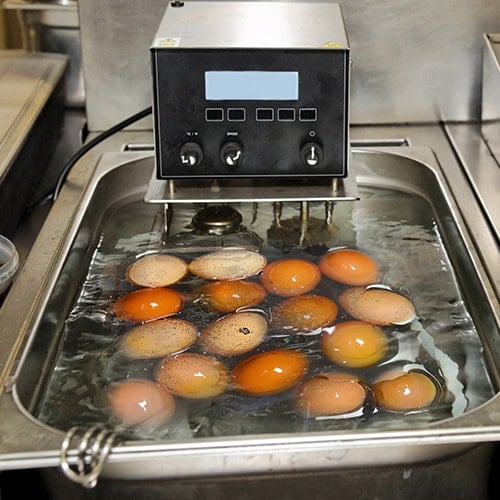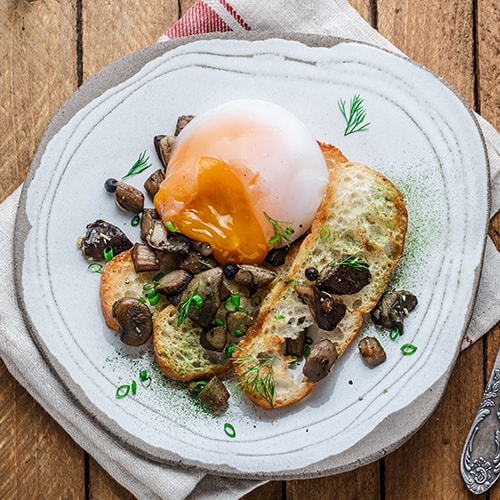Sous vide cooking is known for its ability to create tender proteins, but it also serves as a convenient method for cooking eggs. By immersing the eggs in a water bath, you can easily set the temperature and timing and then leave them to cook undisturbed, freeing you up to focus on other tasks. Sous vide eggs can be prepared in large quantities and stored for future use, making them an excellent choice for busy commercial kitchens. Whether you want to learn about the ideal sous vide egg cooking times and temperatures or explore a delicious egg bite recipe made using sous vide techniques, we are here to guide you through how to cook eggs with an immersion circulator.
Shop All Immersion CirculatorsWhat Are Sous Vide Eggs?

Sous vide eggs are eggs cooked slowly in a water bath held at a precise temperature by an immersion circulator. Sous vide cooking provides precise temperature control ensuring your eggs are cooked evenly and eliminating any risk of overcooking or undercooking. Unlike other forms of sous vide cooking, you do not vacuum seal the eggs before placing them in the water bath because their shells act as a natural case. To make sous vide egg bites, divide the scrambled egg mixture into mini mason jars.
Sous Vide Eggs Temperature
The beauty of cooking eggs sous vide is you have precise control over the temperature, allowing you to achieve the exact level of doneness you desire. The average cook time for a sous vide egg is between 45 and 60 minutes depending on how firm you want your whites. Our recommendations below are for a 60 minute egg. Discover the sous vide water temperature ranges for different levels of egg doneness below.
- Sous Vide Pasteurized Eggs: You can hold eggs in a “raw” state by placing them in an immersion circulator water bath between 130 and 135 degrees Fahrenheit for 75 to 90 minutes. The eggs will be fully pasteurized, making them safer to consume in raw preparation methods like mayonnaise and edible cookie dough. However, the egg yolk and white will remain indistinguishable from a raw yolk and white.
- Poached Eggs Sous Vide: For a perfectly runny yolk that is just a bit thicker than raw and a white that is set enough to cut with a spoon, set your sous vide water bath at 145 degrees Fahrenheit and cook for 60 minutes. To achieve a more polished appearance for your poached sous vide eggs, delicately crack them into a small bowl and use a slotted spoon to extract the egg. This method effectively separates pieces of runny, loose whites from the rest of the egg.
- Soft Boiled Eggs Sous Vide: For a jammy yolk and firm whites, set your sous vide water bath to 150 degrees Fahrenheit and cook for 60 minutes. Soft boiled sous vide eggs have a milder taste than hard boiled eggs but offer a less runny yolk than a traditional poached egg, offering the best of both styles.
- Medium Boiled Eggs Sous Vide: For a medium boiled sous vide egg, cook the eggs for 60 minutes in a water bath set to 155 degrees Fahrenheit. This will give you a classic hard boiled egg perfect for deviled eggs and egg salad.
- Hard Boiled Eggs Sous Vide: For a fully set yolk that is firm but still tender, cook the eggs for 60 minutes in a water bath set to 165 degrees Fahrenheit. This will give you a classic hard boiled egg perfect for deviled eggs and egg salad.
How to Sous Vide Eggs

Cooking eggs with a sous vide machine allows busy restaurants and caterers to prep food in advance. Sous vide eggs are cooked in a water bath at a precise temperature for one hour or 45 minutes depending on how set you want your egg white. Follow these steps to prepare eggs with an immersion circulator:
- Preheat Water Bath: Fill a food storage container with water and attach your sous vide immersion circulator. Set the temperature to match your desired doneness. Refer to our sous vide egg temperature chart above.
- Cook Eggs: Once the water bath has reached the desired temperature, gently lower the desired number of eggs into the water with a spoon. Ensure they are fully submerged. Cook for one hour.
- Remove Eggs: After the cooking time is up, remove the eggs from the sous vide bath with a spoon and add them to a bowl of ice water. Let them rest in the ice bath for 5 minutes.
- Crack Eggs: Remove the eggs from the water bath. Gently crack them and peel away their shells.
- Serve: Serve your poached eggs in individual bowls or add them as a delicious topping to avocado toast, ramen, or pasta.
How to Sous Vide Poached Eggs
If you've ever struggled with achieving the perfect poached egg, sous vide cooking is an effortless solution. To sous vide poached eggs, set your water temperature to 145 degrees Fahrenheit (or 45 minutes if you prefer a less set egg white and liquid yoke). Then, follow the rest of the steps in our guide to making sous vide eggs above. Cooking the eggs at a low temperature gently sets the whites and leaves the yolks velvety and luscious.
How to Make Sous Vide Egg Bites

Learn how to make broccoli, bacon, cheddar sous vide egg bites. These sous vide egg bites have a creamy, souffle-like texture and are an easy way to offer a gourmet continental breakfast item with little effort.
What Special Equipment Do I Need?
To make sous vide egg bites, you’ll need the following items:
- 12 4 ounce mason jars
- Immersion circulator
- Large food storage container
Sous Vide Egg Bites Recipe
Makes: 12 sous vide egg bites
Cook Time: 1 hour
Prep Time: 10 minutes
Total Time: 1 hour and 10 minutes
Ingredients
- 14 eggs
- 1/2 cup milk of choice
- 1/2 teaspoon salt
- 1/2 teaspoon paprika
- 12 ounces chopped bacon
- 1 cup shredded sharp cheddar cheese
- 2 cups broccoli, chopped and steamed
Directions
- Fill food storage container with enough water to submerge mason jars.
- Attach immersion circulator to container and set it to 175 degrees Fahrenheit.
- Spray nonstick cooking spray inside mason jars.
- Divide cheddar and broccoli evenly between mason jars.
- Crack eggs into bowl and whisk with milk, salt, and paprika until scrambled.
- Fill each mason jar 3/4 way full with egg mixture.
- Screw on mason jar lids and then unscrew one turn. This prevents them from exploding in water bath.
- Submerge mason jars in water bath and cook for one hour.
- Remove mason jars with tongs. The sous vide egg bites should look souffle-like. If still runny, cook for longer. If not, they’re ready to serve.
Sous vide eggs have become a popular trend in the culinary world, and it's easy to see why. One of the key benefits of sous vide eggs is their consistency. Unlike traditional methods of cooking eggs, such as boiling or frying, sous vide eggs are cooked at a controlled temperature, ensuring that they are cooked evenly throughout. With their consistent results, convenience, and endless culinary possibilities, sous vide eggs are easy staples in commercial kitchens.








